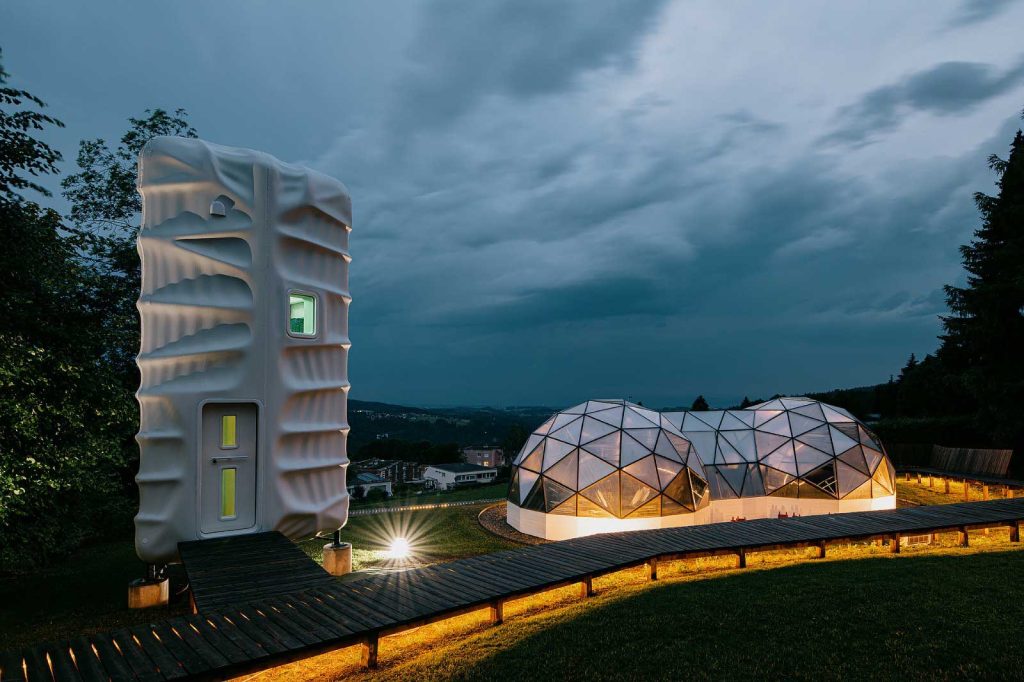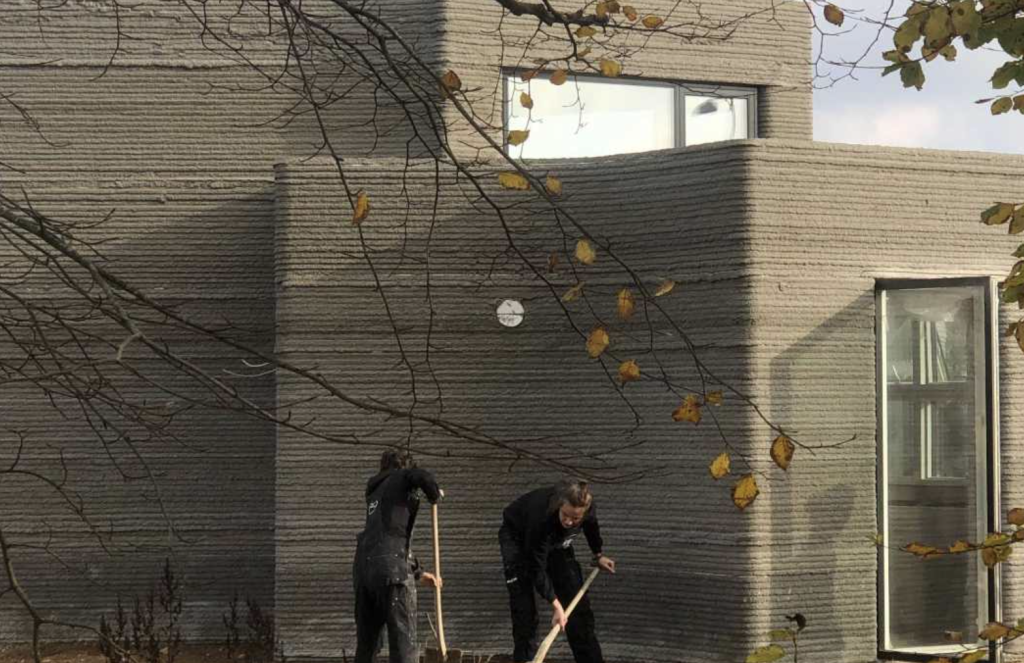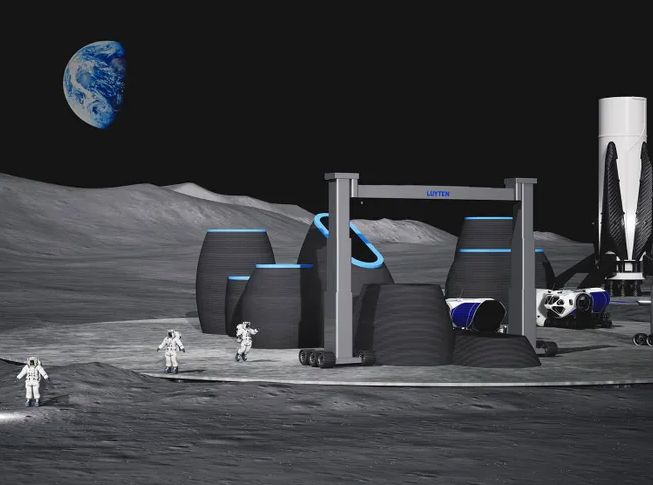Students at Swiss boarding school Institut auf dem Rosenberg have worked with Danish design studio SAGA Space Architects to 3D print a 23-foot-tall extraterrestrial learning space.
Built alongside 3D printing veterans Ingersoll Machine Tools and the Camozzi Group, the Rosenberg Space Habitat (RSH) is said to be the tallest polymeric build of its kind in the world. In practice, the structure, designed to fit into SpaceX’s Starship rocket, is used by students as a lab to explore how living away from Earth affects wellbeing and test advanced space systems.
“At Rosenberg, infusing education with real-life context is at the heart of what we do, rather than focusing on pure academics alone,” said Bernhard Gademann, Director General of Rosenberg. “Our aim is to provide future leaders with early exposure to the question of advanced space exploration, allowing our students to approach and solve these complex questions from a collaborative and holistic point of view.”

SAGA Space Architects’ lunar expertise
The Swiss students have realized their ambition of building a deployable learning habitat thanks to their partnership with SAGA Space Architects. The studio specializes in creating futuristic living spaces for outer space deployment using what it calls ‘Terra-Tech.’ This approach sees the firm combine topology optimization, generative design, and 3D printing to build nature-inspired structures.
To date, SAGA Space Architects has leveraged Terra-Tech to realize everything from office spaces and houses to the aforementioned space habitats. The second of these, the ‘ROSIE,’ features an outer shell that was 3D printed alongside Ingersoll Machine Tools, which has a history of using the technology in large-format applications. In fact, the company is currently working with the US Navy to build the world’s largest metal 3D printer, which is set to be used for building monolithic hulls.
The design studio is also part of the newly-formed 3DCP Group that has partnered with COBOD to construct Denmark’s first concrete 3D printed home. As well as committing to build the 37 square-meter house in Holstebro, the company has continued refining how it uses 3D printing to create architecture and working with students at Rosenberg, it has now returned to the field of space habitats.

Learning to live away from Earth
Unveiled on July 20, 2022, 53 years after humankind first landed on the Moon, the RSH is designed to enable the next generation to learn about the harsh realities of living and working in outer space. The project began over two years ago when Rosenberg students helped SAGA Space Architects troubleshoot issues around its ‘LUNARK,’ an experimental lunar habitat it deployed in Greenland.
Inspired by this experience, the team then started coming up with designs for a house that their resident Boston Dynamics-built robot Spot could live in. From these initial concepts, the idea grew into what is now a full-blown three-story research lab. The RSH’s outer shell was 3D printed in Milan, while its interior structure was built in Copenhagen with the Camozzi Group and Ingersoll Machine Tools.
According to the students, using polymer 3D printing in the build was “revolutionary,” as it provided them with greater versatility than concrete would have done. The team behind the RSH also integrated a UV stabilizer into their material mix. In doing so, they found it possible to make the feedstock flexible, durable, and recyclable in a way that enabled them to break it down and reprint it where needed.
Built to house two crew members simultaneously, the structure is set to act as a research center where students can engage in immersive learning modules that foster creative problem-solving skills. Across its three floors, the first includes hygiene, lab research, and facilities for working with partners like ABB Robotics. The second and third are meant for other work, recreational activities, and sleep.
In terms of testing, the RSH is expected to house experiments that explore human wellbeing and those focused on developing software and hardware, such as remote mission control systems. Residents of the facility will also carry out research on sensory stimulation in remote living environments and work with advanced technologies such as automated mechatronics and AI deep learning programs.
“The Rosenberg Space Habitat is state-of-the-art in analog space habitats. It was developed in record time from initial sketches to the final fully functioning habitat in just months,” said Sebastian Frederiksen, Founder of SAGA Space Architects. “This is a great example of how working with outer space is pushing the boundaries of technology and architecture here on Earth as well, as this is the tallest 3D printed plastic ‘house’ in the world.”
“This is just the beginning of the habitat, and now the research and education begin. Hopefully, we are going to learn a lot about living on the Moon.”

Circular regolith-based lunar habitats
While the Rosenberg team’s project has seen them use 3D printing to build a largely polymeric space habitat, research elsewhere has often focused on using lunar regolith to build such structures instead. Engineers at the University of New South Wales are working with Luyten to accelerate the R&D of the Platypus Galacticas, a gantry-mounted 3D printer capable of building structures from lunar soil.
Scientists from the Technical University of Braunschweig and Laser Zentrum Hannover (LZH), on the other hand, have 3D printed lunar regolith under zero gravity for the first time. As part of the experimental MOONRISE project, the team have mounted a custom laser to their ‘MIRA3D’ lunar rover before using it to melt moondust into shapes.
More recently, NASA’s Kennedy Space Center and AI SpaceFactory have also unveiled designs for the 3D printed ‘LINA’ lunar outpost. Designed to be built from a regolith-polymer composite, the facility is meant to act as a long-lasting structure, capable of supporting long-term habitation and future travel to other planets.
To stay up to date with the latest 3D printing news, don’t forget to subscribe to the 3D Printing Industry newsletter or follow us on Twitter or liking our page on Facebook.
For a deeper dive into additive manufacturing, you can now subscribe to our Youtube channel, featuring discussion, debriefs, and shots of 3D printing in-action.
Are you looking for a job in the additive manufacturing industry? Visit 3D Printing Jobs for a selection of roles in the industry.
Featured image shows the Rosenberg Space Habitat installed at Institut auf dem Rosenberg’s experimental ‘Future Park.’ Image via Institut auf dem Rosenberg.



